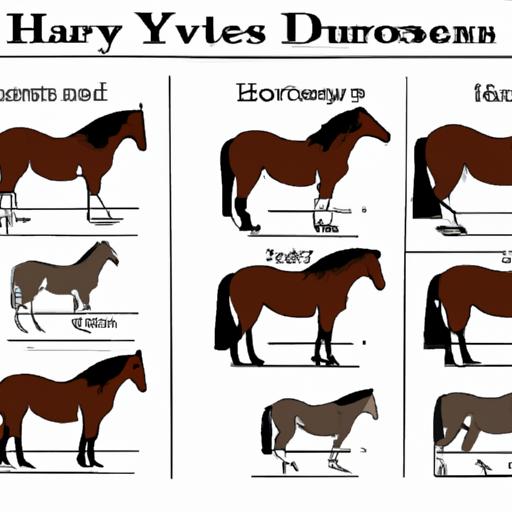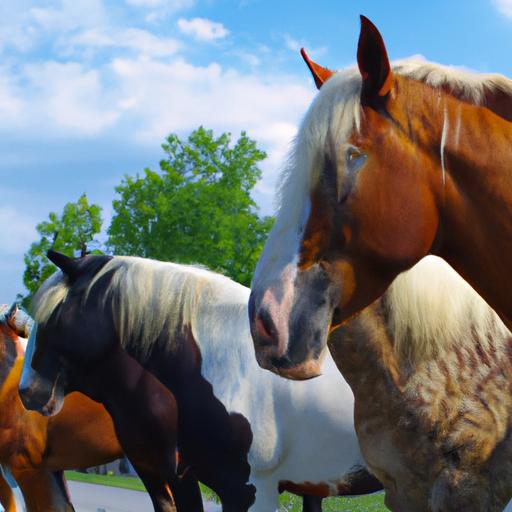Discover the power of draft horse breeds by size. Explore the importance of comparing sizes, factors to consider, and pros/cons in various contexts.
If you’ve ever marveled at the awe-inspiring strength and grace of draft horses, you know they are a breed apart. From pulling heavy loads to working in agriculture, draft horses have been our steadfast companions for centuries. But did you know that understanding draft horse breeds by size holds the key to unlocking their full potential? In this article, we’ll delve into the world of these magnificent equine giants and explore why their size matters.
Overview of Draft Horse Breeds
Before we embark on this journey, let’s take a moment to appreciate the vast diversity of draft horse breeds. From the elegant Shire horses to the robust Clydesdales, draft horses come in various shapes and sizes. Each breed exudes its own unique charm, making it essential to understand their characteristics to find the perfect fit for your needs.
Importance of Understanding Draft Horse Breeds by Size
Why is it crucial to comprehend the different sizes of draft horse breeds? Well, imagine trying to navigate a narrow path with a large draft horse or attempting to pull a heavy load with a smaller breed. By understanding draft horse breeds by size, you gain insight into their capabilities, limitations, and suitability for specific tasks. Whether you’re looking for a powerful workhorse or a versatile companion, knowledge of their size can guide you towards the perfect match.
Unveiling “Draft Horse Breeds by Size”
Now, let’s address the main keyword of our discussion: “draft horse breeds by size.” This keyword emphasizes the significance of size when exploring and selecting draft horse breeds. By examining the various sizes in which these magnificent creatures come, we can uncover a world of possibilities tailored to our specific needs.
As we journey deeper into this article, we’ll explore the different categories of draft horse sizes, discuss specific breeds within each category, and examine the advantages and applications of each. Get ready to be captivated by the allure of small, medium, and large draft horse breeds as we unveil their hidden potential.
So, fasten your seatbelts, my fellow equestrian enthusiasts, as we embark on an adventure into the realm of draft horse breeds by size. Together, we’ll unravel the secrets behind these majestic equines and discover the perfect steed for your aspirations.
Small Draft Horse Breeds

Definition and Characteristics of Small Draft Horses
When we talk about small draft horse breeds, we refer to those that possess remarkable strength despite their comparatively compact size. These equine powerhouses may not be as towering as their larger counterparts, but they make up for it with their unwavering determination and agility. Small draft horses typically stand between 14.2 and 16 hands high, allowing them to navigate tight spaces and maneuver with precision.
Examples of Small Draft Horse Breeds and Their Size Specifications
-
Belgian Draft Horse: The Belgian Draft Horse, known for its gentle and docile nature, stands around 15 to 16 hands high. Despite its smaller stature, it possesses incredible strength, making it ideal for light to moderate heavy pulling tasks. With its characteristic sorrel coat and muscular build, the Belgian Draft Horse has become a beloved breed in the world of equine enthusiasts.
-
Suffolk Punch: Originating from England, the Suffolk Punch is a small draft horse breed that stands approximately 15.2 to 16.2 hands high. With its distinctive chestnut coat and sturdy build, this breed is known for its strength and versatility. The Suffolk Punch excels in agricultural work, forestry, and even under saddle, making it a prized companion for those seeking a reliable, smaller draft horse.
Discussion on the Suitability and Uses of Small Draft Horse Breeds
While small draft horse breeds may not possess the sheer size and strength of their larger counterparts, they offer various advantages in specific contexts. Their compact size makes them well-suited for tasks that require maneuverability, such as logging in dense forests or working on smaller farms. Additionally, their agility allows them to excel in disciplines like driving competitions and pleasure riding. If you’re in need of a strong, versatile partner that can navigate tight spaces with finesse, a small draft horse breed might be the perfect match for you.
In conclusion, don’t let their smaller stature fool you. Small draft horse breeds possess an incredible amount of power, agility, and versatility. From the robust Belgian Draft Horse to the majestic Suffolk Punch, these equine gems offer unique characteristics and capabilities that make them indispensable in various domains. Whether you’re looking for a reliable workhorse or a companion for recreational activities, small draft horse breeds can provide the perfect blend of strength and maneuverability to suit your needs. Stay tuned as we explore the world of medium draft horse breeds in the next section!
Medium Draft Horse Breeds
Definition and Characteristics of Medium-Sized Draft Horses
When it comes to draft horse breeds, the medium-sized ones strike a perfect balance between strength and agility. These horses possess an impressive stature, making them capable of performing heavy tasks while maintaining a certain level of versatility. Medium draft horses typically stand between 15 to 16 hands high (60 to 64 inches) at the shoulder and weigh around 1,500 to 1,800 pounds.
One defining characteristic of medium draft horses is their well-rounded conformation. They boast a solid build with a muscular physique, enabling them to handle substantial workloads. Additionally, their temperament often leans towards being calm and gentle, making them not only formidable workers but also delightful companions.
Examples of Medium Draft Horse Breeds and Their Size Specifications
Now, let’s explore some notable medium draft horse breeds and gain insight into their size specifications. One prominent breed in this category is the Belgian draft horse. Belgians often stand around 16 to 17 hands high (64 to 68 inches) and have a weight ranging from 1,800 to 2,200 pounds. Renowned for their strength and docile nature, Belgians excel in agricultural work and are frequently utilized in logging operations.
Another remarkable medium draft horse breed is the Percheron. Percherons typically measure between 16 to 18 hands high (64 to 72 inches) and weigh approximately 1,800 to 2,600 pounds. Known for their elegance and athleticism, Percherons have a versatile nature, making them suitable for various tasks such as pulling carriages, participating in competitive events, and even providing therapeutic interactions.
Discussion on the Versatility and Applications of Medium Draft Horse Breeds
The versatility of medium draft horse breeds is truly remarkable. Their size enables them to handle a wide range of tasks, making them valuable assets in various industries. Whether it’s plowing fields, hauling heavy loads, participating in parades, or even engaging in recreational activities, medium draft horses prove themselves to be reliable and adaptable partners.
Their strength, combined with their moderate size, allows medium draft horses to navigate challenging terrains more easily compared to their larger counterparts. This advantage makes them suitable for work in hilly or uneven landscapes where maneuverability is essential. Furthermore, their calm demeanor and willingness to learn make them popular choices for novice handlers seeking dependable equine companions.
In conclusion, medium draft horse breeds offer a harmonious blend of power and versatility. Their size, conformation, and temperament make them ideal for a wide range of tasks, ensuring their relevance in various industries and recreational pursuits. Whether you need a steadfast partner for farm work or a reliable companion for equestrian endeavors, the medium draft horse breeds have got you covered.
Large Draft Horse Breeds
Definition and Characteristics of Large Draft Horses
When we think of sheer power and size, large draft horses immediately come to mind. These gentle giants possess a robust build and an imposing stature that makes them ideal for heavy-duty tasks. Large draft horses are typically defined as those standing over 16 hands (64 inches) at the withers, showcasing their impressive height and muscular physique. Their broad chests, sturdy legs, and strong backs make them a force to be reckoned with.
Examples of Large Draft Horse Breeds and Their Size Specifications
Within the realm of large draft horse breeds, a few notable names stand out. The Clydesdale, known for its feathered feet and high-stepping gait, is a prime example. These majestic creatures can reach heights of up to 18 hands (72 inches) and weigh over a ton. Another remarkable breed is the Belgian, renowned for its exceptional pulling power. Belgians typically stand between 16 and 18 hands (64-72 inches) tall, with the stallions weighing around 2,000 pounds.
Discussion on the Strength and Specific Purposes of Large Draft Horse Breeds
The strength of large draft horse breeds is truly awe-inspiring. These magnificent animals have the ability to effortlessly pull heavy loads, making them invaluable in agriculture, forestry, and logging industries. Their immense size and power allow them to tackle arduous tasks with ease, whether it’s hauling timber, plowing fields, or even participating in competitive pulling events. Beyond their sheer strength, large draft horses also exhibit gentle dispositions, making them ideal for working closely with humans and providing therapeutic interactions.
Large draft horse breeds bring a unique set of qualities to the table, making them indispensable in various industries and activities. Their size and strength, combined with their gentle nature, make them perfect partners for demanding tasks and companions for those seeking a powerful yet docile equine companion.
As we move forward in our exploration, we’ll shift our focus to comparing draft horse sizes, delving into the pros and cons of different sizes and their suitability for specific purposes. Stay tuned as we uncover the secrets behind harnessing the full potential of these remarkable draft horse breeds.
Conclusion
In conclusion, understanding draft horse breeds by size is paramount when it comes to harnessing the incredible power and versatility of these magnificent creatures. By delving into the world of small, medium, and large draft horse breeds, we have uncovered a wealth of knowledge that can guide us towards selecting the perfect equine partner for our specific needs.
Throughout this article, we explored the importance of comparing draft horse sizes for specific tasks and requirements. Whether you’re looking for a nimble and agile companion or a robust powerhouse, considering the size of the draft horse breed is crucial. It allows you to match the horse’s capabilities with the demands of the job at hand, ensuring optimal performance and a harmonious partnership.
When selecting a draft horse breed based on size, several factors come into play. Consider the nature of the task, the environment in which the horse will work, and the level of physical exertion required. By carefully evaluating these factors, you can identify the breed that best aligns with your needs and maximizes efficiency and effectiveness.
Like everything in life, different draft horse sizes come with their own set of pros and cons. Small draft horse breeds excel in agility and versatility, making them ideal for tasks that require maneuverability. Medium-sized draft horses strike a balance between strength and agility, making them suitable for a wide range of applications. Large draft horse breeds, on the other hand, possess tremendous power and are well-suited for heavy-duty tasks that require immense strength.
In conclusion, understanding the nuances of draft horse breeds by size empowers us to make informed decisions when it comes to selecting the right horse for the job. By acknowledging the diversity and capabilities of small, medium, and large draft horse breeds, we can forge strong bonds and accomplish remarkable feats alongside these majestic equines.
So, whether you’re embarking on agricultural endeavors, engaging in heavy pulling, or simply seeking an incredible equine companion, remember the importance of draft horse breeds by size. With this knowledge in your arsenal, you can confidently navigate the world of draft horses, harness their true potential, and unlock extraordinary achievements.
Bold – Horsemasterypro.com


